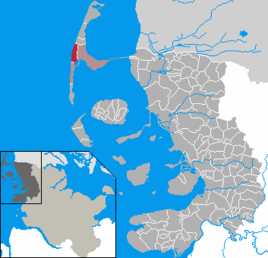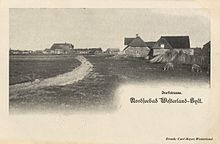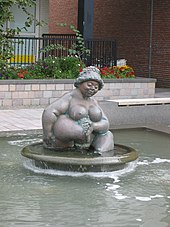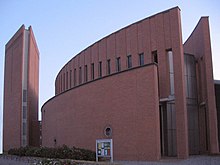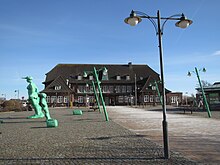Westerland
|
Westerland
Sylt municipality
|
|
|---|---|
| Coordinates: 54 ° 54 ′ 28 " N , 8 ° 18 ′ 32" E | |
| Height : | 5 m above sea level NHN |
| Area : | 10.45 km² |
| Residents : | 9032 (Dec. 31, 2007) |
| Population density : | 864 inhabitants / km² |
| Incorporation : | January 1, 2009 |
| Postal code : | 25980 |
| Area code : | 04651 |
|
Location of the former city in the district of North Friesland
|
|
Westerland ( Danish : Vesterland , North Frisian : Wäästerlön or Weesterlön ) is a district of the municipality of Sylt in the district of North Friesland in Schleswig-Holstein and the capital of the North Sea island of Sylt . From 1905 to 2008 Westerland had town charter. Westerland is around 74 kilometers west of Flensburg , 134 kilometers northwest of Kiel and 186 kilometers northwest of Hamburg .
history
Until it was designated as a seaside resort in 1855
The formerly independent city of Westerland is the youngest town on Sylt after Hörnum . After Eidum was completely destroyed by the All Saints flood on November 1, 1436 , the survivors founded a new place on the heather north-east of the old settlement. The name Westerland is probably derived from an old Tinnum field name on which this new settlement arose: It was the land west of the village, i.e. the Wester-Land . Today's Alt-Westerland was first mentioned in a document in 1462.
After the former Eidumers had used their church standing between the dunes for 200 years , which was still marked on Johannes Mejer's map in 1648 , they began to build their own church on the eastern edge of their new village in 1635, today's village church of St. Niels how the Eidum Church was dedicated to Nikolaus von Myra , the saint of sailors. The inventory and the bell come from the old Eidum church.
Westerland consisted of only 124 houses in 1778 and was so poor that not a single landowner could live on his land because the fertile marshland was either washed away by the sea or silted up by the dunes, as the church council wrote to the duke, connected with the Please approve a collection for the renovation of the now dilapidated church.
The seaside resort before the construction of the Hindenburg dam
In 1855 the place received the title of a seaside resort . The approximately 500 residents accommodated 98 guests in the first season. Soon Westerland was considered to be the most progressive pool, as men and women were allowed to bathe together in the so-called family pool. The first newly built hotel in the village was the Dünenhalle , opened in 1858 , later Hotel Union on Deckerstrasse. This house survived the times until it was demolished in 2002. Westerland only became the capital of the island when it was recognized as a seaside resort; Until then, Keitum had been the main town on Sylt for centuries ; For example, the only pharmacy on the island was located there until the beginning of the 20th century. Due to its central location at the intersection of all traffic axes and due to its proximity to the beach, Westerland's island supremacy has been consolidated over the past 150 years. In 1905 Westerland was finally granted city rights .
The many Catholic spa guests prompted the building of a Catholic church, the Herz-Jesu-Kirche, in 1896. This was followed in 1957 by a larger building, the Christophorus Church . The old church was then torn down by the city of Westerland. Due to the poor quality of construction, however, a decision was made in the 1990s to tear it down and replace it with a new building in the same place, which was inaugurated on Palm Sunday in 1999.
When the small village church of St. Niels was no longer sufficient for the rapidly growing population and the large number of guests, the town church of St. Nikolai was also built in 1908.
→ Main article: St. Nicolai (Westerland)
Since the construction of the Hindenburgdamm
In the 1920s, Westerland was on the way to becoming a fashionable seaside resort. During the time of National Socialism , Westerland, which until then had been considered friendly to Jews , was one of the beach baths that refused to accept Jews in 1934. With that, it lost much of its previous audience.
In 1949 it was finally recognized as a seaside spa . Many old villas and lodging houses fell victim to the construction boom that hit the city in the 1960s. Between 1951 and 1964, the former SS group leader Heinz Reinefarth was one of the commanders in the suppression of the Warsaw Uprising as mayor of Westerland.
The cityscape changed significantly in the 1960s. Large apartment blocks and hotels emerged as a result of the tourism boom. Most noticeable here was the Westerland spa center , which was built between 1966 and 1969. The three apartment blocks still tower above all other buildings in 2013. A long-lasting dispute broke out over another large building, the planned Atlantis holiday center , which was to include a 25-storey spa center, 750 apartments and 1200 underground parking spaces. The building was finally stopped by the Ministry of the Interior in Kiel, further urban development no longer relied exclusively on modern apartment blocks.
In 1988 the band Die Ärzte from Berlin wrote a song about Westerland , which is still one of their greatest hits today.
On May 25, 2008, the merger with the municipality of Sylt-Ost was decided by a referendum on January 1, 2009. Since January 1, 2009, these two communities together with Rantum have formed the new community of Sylt .
Population development

- 1755: 490 inhabitants
- 1804: 437 inhabitants
- 1905: 2,292 inhabitants
- 1934: 3,614 inhabitants
- 1939: 6,209 inhabitants
- 1946: 10,957 inhabitants (clearly recognizable the high number of refugee families)
- 1961: 8,507 inhabitants
- 1968: 11,020 inhabitants (all second home owners were also recorded here)
- 1979: 9,525 inhabitants (from here without second home owners)
- 2006: 8,973 inhabitants
- 2007: 9,072 inhabitants
politics
Mayor (1905-2008)
- 1905–1908 Mayor Kindler
- 1908–1915 Mayor Martin Frommhold
- 1915–1920 City Secretary Kapp administered the office of mayor
- 1920–1933 Mayor Kapp
- 1933–1934 Mayor Findeisen
- 1934–1938 mayor and health resort director Schuldt
- 1938–1939 Comm. Mayor, Ortsgruppenleiter Jacobsen
- 1939–1940 Mayor Fiedler
- 1940–1942 Mayor Freiherr Traugott v. Heintze
- 1942–1943 Mayor Bergmann
- 1943–1944 Comm. Mayor Chief Inspector Schmidt
- 1944 Come. Mayor Böhm
- 1944 Komm. Mayor Ortsgruppenleiter Jacobsen
- 1945 Mayor Kapp
- 1945 Come on. Mayor Momsen
- 1946–1951 Mayor Andreas Nielsen
- 1951: Mayor of Lobsia
- 1951–1964: Heinz Reinefarth , GB / BHE
- 1964–1976: Ernst Schilling CDU
- 1976–1991: Volker Hoppe, CDU
- 1991–2008: Petra Reiber, independent (2009–2015 mayor of the municipality of Sylt)
coat of arms
Blazon : “In silver over blue-silver waves, a red lighthouse with a golden lantern, from which three red, gold shimmering beams emanate to the right and left. The masonry below the lantern is covered with a divided sign: above silver without a picture, below blue with a silver herring inside. "
Culture and sights
General
Westerland has with the " graveyard of the homeless " a special cemetery for the nameless driven dead sailors with a central time, a mighty boulder that of the Romanian Queen Elisabeth of Wied was founded in 1888 and with a poem of the hymn poet and court chaplain Rudolf Kögel is provided . On June 11, 1896, a monument to Heinrich von Stephan based on a design by the sculptor Hugo Berwald was unveiled . Westerland is also known for its long promenade along the west beach: it is over six kilometers long and has existed for over 100 years. On this promenade, there are regular spa concerts in the so-called "music shell" in the evenings. The Sylt Aquarium , opened in 2004, offers visitors an insight into the underwater world of the seas. Since 2001, the sculpture ensemble by the artist Martin Wolke The Giant Travelers has stood on the forecourt of Westerland station.
Historical buildings
- St. Niels Church (consecrated 1637)
- The old village church of Westerland contains a number of valuable works of art. The tower was built in 1875.
-
Church of St. Nicolai from 1906–1908
The construction of the neo-Romanesque town church became necessary because the old village church of St. Niels had become too small. -
Kurhaus from 1897
After the end of the First World War , entertainment venues, bars and gaming rooms were set up there. Today the building houses the town hall and the casino. - Westerlander Roland
- Catholic Church of St. Christophorus
The church, built in 1999, is a remarkable postmodern building -
Staldkirken
The Danish church is located in a Friesenhof from 1780.
Economy and Infrastructure
The economy of Westerland is very much geared towards the island's tourism . In 2002, Westerland was the second most important place for tourism in Schleswig-Holstein after Sankt Peter-Ording : 96,120 guests, of which 271 (0.28 percent) from abroad, booked 819,935 overnight stays. The city had 9,159 guest beds. There is a campsite in the south of the city.
Westerland is a supply center for the island of Sylt; Retail and service providers cater to residents and guests across the island.
The Adler-Schiff shipping company is based in Westerland.
traffic

On Sylt, as on all North Frisian islands, car traffic is permitted. There is a well-developed road network in Westerland and plenty of (partly chargeable) parking spaces. In the 1970s and 1980s, a night driving ban was introduced in some streets of the "Kurzentrum" in Westerland, for the implementation of which some streets were closed with a barrier at night from 10:00 pm, so that no car traffic was possible. The night driving ban was lifted again in 1998 and the barriers dismantled.
Rail transport
Sylt and thus also Westerland cannot be reached by road. Instead, there is a connection with the Sylt-Shuttle or RDC Autozug Sylt called Autozug between Niebüll and Westerland (Sylt) . The railway line, also known as the Marschbahn , leads over the 11.3 kilometer long Hindenburg dam through the Wadden Sea . Passenger traffic is carried out by Deutsche Bahn with InterCity trains and local trains.
Transportation
Westerland is centrally located on Sylt. In addition to the train station with connections in an easterly direction to Keitum and Morsum, there are Sylter Verkehrsgesellschaft bus routes going south to Hörnum and north to List. These lines as well as the Westerland – Munkmarsch line represent the former network of the Sylt Inselbahn , whose operation was discontinued in 1970. There are two city bus routes in Westerland, one of which runs through the north of the city to the North Sea Clinic and the other runs through the south of the city. This bus line is intended to better connect the now scattered residential areas of the city to the city center.
Air traffic
Westerland can still be reached by scheduled and charter services via Sylt Airport, which is around two kilometers east of the city center .
Shipping
Westerland itself does not have a port, but there are ferry connections to the neighboring islands from the ports in Hörnum and List. Sylt can be reached by car ferry on the Rømø-Sylt-Linie from the Danish neighboring island of Rømø . There is also a ferry line - without car transport - from Nordstrand via Amrum to Hörnum .
education
Westerland has two primary schools, a community school and a grammar school (Sylt grammar school) . There is also a Danish primary and secondary school (Vesterland-Kejtum Danske Skole) and a special needs school. The vocational schools in the Nordfriesland district have a branch in Westerland.
The Volkshochschule Sylt is responsible for adult education.
In Westerland there is a district office of the North Friesland District Music School .
Transmitter
→ See: Sender Westerland
Personalities
- The Romanian Queen Elisabeth zu Wied (1843–1916; poet with the pseudonym Carmen Sylva ) visited Westerland regularly in the early days of the baths and made the bath “acceptable” in aristocratic circles. Elisabethstrasse in the city center is named after her.
- The Evangelical Lutheran pastor Heinrich Rendtorff (1888-1960) was born in Westerland, he was also regional bishop of the Evangelical Lutheran Church of Mecklenburg and from 1926 to 1930 and 1945 to 1956 professor of practical theology in Kiel.
- The actor Uwe Dallmeier (born August 27, 1924 in Dithmarschen) died here at his place of residence on November 19, 1985.
- The Sylt chronicler Harald Voigt (1928–2005) made a name for himself with numerous publications and publications about the history of Sylt.
- The punk rock band Die Ärzte played their farewell concert in Westerland on July 9, 1988, before their temporary dissolution in the same year.
→ See also the list of Sylt personalities
graveyards
literature
- Herbert Bruns : SYLT - nature, recreation, research, teaching, environmental pollution, island planning and citizens' initiative. Documentation from the fight against 'Atlantis' and for Sylt . Volume 4 (No. 37-52) in the series Biologische Abhandlungen , Biologie-Verlag, Wiesbaden 1975.
- Manfred Wedemeyer and Harald Voigt : Westerland. Bath and city through the ages. City of Westerland, Westerland 1980.
Web links
Individual evidence
- ^ Peter Schmidt-Eppendorfer: Sylt. Memoirs of an Island. Documents, chronicles, reports from 1001 years , Husum 1977, pp. 74-75
- ↑ Catholic Church - Deanery Flensburg ( Memento from May 4, 2015 in the Internet Archive )
- ^ Germans and Poles: Heinz Reinefarth, Der Henker von Warsaw . At: Rundfunk Berlin-Brandenburg
- ↑ Wolf Gütschow, Volker Frenzel: Sylt - the great decades , Medien-Verlag Schubert, ISBN 3-929229-96-X , p. 72
- ↑ Westerland and Sylt-Ost merge ( memento from September 19, 2012 in the web archive archive.today ) . In: shz.de
- ↑ StBA: Area changes on 01/01/2009
- ↑ Places, cities, communities in the district of North Friesland
- ↑ Schleswig-Holstein's municipal coat of arms

